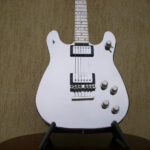The world of guitar modes can initially seem complex, but each mode offers a unique sonic landscape for your playing. Among these, the Dorian mode stands out as a particularly versatile and engaging option. Often described as the “cheerful minor mode,” Dorian provides a rich, jazzy flavor that can add depth and sophistication to your guitar riffs and solos.
In this comprehensive guide, we’ll delve into the Dorian Guitar Scale, equipping you with the essential knowledge to incorporate it into your musical vocabulary. You’ll learn the scale pattern, discover chords that harmonize beautifully with Dorian, and gain access to backing tracks to immediately put your newfound skills into practice.
Why Explore the Dorian Mode?
The Dorian mode is more than just another scale; it’s a gateway to a distinct and captivating sound. While it shares the same fundamental building blocks as the major scale – the familiar whole and half step pattern – Dorian distinguishes itself by starting on the second degree of the major scale. This shift in perspective unlocks a world of musical possibilities.
- Versatile Musical Moods: Dorian isn’t limited to a single emotion. It can evoke a range of moods, from introspective and melancholic to upbeat and funky, making it incredibly adaptable across genres.
- The Uplifting Major 6th: A key characteristic of Dorian is the presence of a major 6th interval. This bright, major quality injects a sense of optimism and jazziness into the inherently minor sound, setting it apart from other minor scales.
- The Natural 9th’s Value: Dorian also boasts a natural 9th interval, adding a further layer of melodic interest and harmonic richness. This note expands the melodic possibilities and contributes to the mode’s sophisticated sound.
- Funk-Ready Minor Chords: The Dorian mode perfectly complements minor chords that incorporate a major 6th. These chords are a staple in funk music and provide an ideal harmonic foundation for Dorian-based melodies and improvisations.
Dorian Mode: Unpacking the Theory
Let’s explore the theoretical underpinnings of the Dorian mode to understand what makes it tick:
- Popular Minor Mode: Dorian’s popularity among guitarists stems from its unique sonic qualities. It possesses a near-dominant sound that creates a pleasing tension, a tendency towards “twanging” tonalities that are great for blues and rock, and a natural fit for cool jazz sensibilities.
- Mixolydian Relative: Interestingly, Dorian shares a similarity with Mixolydian, another mode. Mixolydian is a major mode that also features a b7 (flat 7th). However, Dorian firmly resides in the minor realm due to its crucial b3 (flat 3rd) interval, which defines its minor character.
- Minor Pentatonic Bonus: A fantastic bonus for guitarists familiar with the minor pentatonic scale: the minor pentatonic scale is entirely contained within the Dorian mode. Learning Dorian essentially expands your minor pentatonic vocabulary!
The following chord voicing beautifully encapsulates the essence of the Dorian scale, highlighting its key intervals:
Mastering the Dorian Scale Pattern: A Step-by-Step Approach
Learning a new scale pattern can feel daunting, but breaking it down into manageable steps makes the process much smoother. Here’s a four-step method to effectively learn the Dorian scale pattern:
- One-Octave Memorization: Begin by focusing on a single octave of the Dorian scale. Play it repeatedly to commit the notes to muscle memory.
- Scale Degree Recognition: Play the same octave again, but this time, verbally name each scale degree as you play (1, 2, b3, 4, 5, 6, b7, 1). This connects the physical pattern with the theoretical understanding of the scale.
- Sing What You Play: Elevate your ear training by singing each note before you play it. This strengthens the connection between your ear, voice, and fingers, deepening your internalization of the Dorian sound.
- Full Pattern Expansion: Once you’re comfortable with the one-octave version, tackle the full Dorian scale pattern that spans across all six strings of the guitar.
Here’s the one-octave Dorian pattern to get you started with steps 1-3:
And here is the complete Dorian scale pattern (step 4). Notice its intriguing resemblance to the minor pentatonic shape!
Putting Dorian into Musical Practice
Learning the Dorian scale pattern is just the first step. To truly master it, you need to apply it in a musical context. The initial focus should be on:
- Internalizing the Sound: Listen intently to the characteristic sound of the Dorian mode. Pay attention to the unique flavor created by the major 6th and natural 9th.
- Identifying “Money Notes”: Discover the notes within the Dorian scale that sound particularly compelling and expressive when played over Dorian-based chords. These are your “money notes” for soloing and melodic improvisation.
The following backing track in C Dorian provides the perfect canvas to begin your Dorian exploration.
Start by simply playing the C Dorian scale pattern you just learned over the backing track. Concentrate on how each interval of the scale interacts with the underlying tonic chord.
Soloing with Dorian Over a Backing Track
Now it’s time to unleash your creativity and solo using the Dorian mode. Use the D Dorian backing track below as your playground.
- Embrace Expressive Techniques: Incorporate guitar techniques like slides, hammer-ons, pull-offs, and vibrato to add nuance and emotion to your Dorian lines.
- Craft Melodic Phrases: Move beyond simply running scales. Experiment with creating short, memorable musical phrases using three or four notes from the Dorian scale.
- Sing and Then Play: A powerful practice technique is to sing a melodic line in your head first, and then translate it to your guitar using the Dorian scale. This connects your inner musical voice to your instrument.
If you’re seeking further guidance on developing your guitar soloing skills, explore resources like “5 Levels of Guitar Soloing: From Beginner to Advanced” for valuable insights and techniques.
Dorian Chord Progressions to Fuel Your Creativity
For deeper Dorian exploration, crafting your own backing tracks using chord progressions is incredibly beneficial. If you have a looper pedal or a recording setup, try these progressions:
Chord Progression #1: Dorian Vamp
This progression creates a static vamp, ideal for exploring the Dorian mode over a single chord:
The inclusion of the major 6th (13th) in the Am6 chord provides a perfect harmonic environment for exploring the A Dorian mode over this static vamp.
Chord Progression #2: Dynamic Dorian Progression
This progression offers a more complex and harmonically rich context for Dorian:
Let’s analyze this progression to understand how Dorian fits in:
- Finding “Home”: The Cmaj7 chord establishes C major as the tonal center, our “home” key.
- The Subdominant ii Chord: The Dm9 chord (the ii chord in C major) functions as the subdominant. It acts as a “pre-dominant” chord, leading towards the dominant V7 (G7).
- Tension and Release: The Dm9 chord creates harmonic tension, although less strongly than a dominant chord. It plays a crucial role in the tension and release dynamic of the progression.
- Dorian over the ii Chord: While Dorian is a fantastic choice over a ii chord like Dm9, remember that the minor pentatonic scale (especially with an added 9th) can also be a very effective and simpler option.
Key Takeaways for Dorian Mastery
To conclude, here’s some essential advice to guide your journey with the Dorian mode:
- Minor Pentatonic Shortcut: Don’t underestimate the power of the minor pentatonic scale! Often, adding just a single color note (like the major 6th or natural 9th) to your minor pentatonic lines can instantly evoke a Dorian flavor.
- Gradual Dorian Expansion: A great approach is to start your solos using the familiar minor pentatonic scale and then gradually expand into the full Dorian mode by selectively incorporating the 9th and 13th intervals.
- Dorian for Jazzy ii-V-I: Dorian is an excellent choice for improvising over the ii chord in a jazzy ii-V-I progression, regardless of the key.
- Pattern-Based Practice: Instead of just mindlessly running scales and arpeggios, focus on practicing three or four-note melodic patterns within the Dorian mode. This fosters musicality and creativity.
By understanding its theory, mastering its patterns, and applying it practically with backing tracks and chord progressions, you’ll unlock the captivating “cheerful minor” sound of the Dorian guitar scale and add a valuable dimension to your guitar playing.
Author: Julia Mahncke
Julia Mahncke is a journalist and musician based in Pittsburgh, PA. Holding a degree in musicology from the University of Bonn and a guitar performance degree from the University of Oregon, Julia is a skilled guitarist with a knack for communicating musical concepts in a straightfoward manner.
She has written, recorded, and performed music as a solo artist, as part of a duo, and as the lead guitarist for the band Meeping. With hundreds of shows under her belt, Julia plays bass in various projects, enjoys participating in jam sessions in Pittsburgh, and remains active as a singer-songwriter.
Featured Course
7 Major Scale Modes in 7 Days
Sam Blakelock
Take the headache out of learning modes.
Featured Pickup Music Instructor
Sam Blakelock
Sam Blakelock is a guitarist, educator, and the founder of Pickup Music. He’s an expert at helping guitarists of all levels tackle fundamental techniques and complex topics in a straightforward & practical way.


